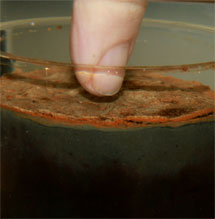
Underwater mud can conduct electricity, possibly with the help of bacteria in the sediment -- a result that helps explain the large amount of electrical activity researchers have detected in ocean sediments, a study published in this week's in Nature reports.
The finding could change how researchers think about microbes' contributions to geochemical processes.
The finding could change how researchers think about microbes' contributions to geochemical processes.
"It's an interesting and important contribution," said Dirk de Beer from the Max Planck Institute for Marine Microbiology, who was not involved in the study. The findings show that processes crucial for life in underwater environments, such as oxidation and reduction reactions, "run faster than we think they can, and in places where we don't expect them," said de Beer.
Researchers made the discovery, because, like many great scientist, they got lazy about cleaning their petri dishes, said lead author Lars Peter Nielsen from Aarhus University in Denmark. "We had some stinky mud standing in the lab," said Nielsen, and they noticed that the sulfides -- "the stinky part" in the upper centimeter of the mud -- changed color over time, indicating that the sulfide had been oxidized. Sulfides are present in mud that lacks oxygen, which should have been true of all the mud in Nielsen's petri dish save that at the very surface, and yet as far as a centimeter down, the sulfur had been converted into elemental sulfur -- a process that requires an electron acceptor like oxygen.
When they depleted oxygen from the surface water, sulfide levels in the mud rose, and when oxygen was bubbled back into the water, the sulfide levels dropped. Oxygen can't diffuse into the mud as quickly as this fluctuation took place; instead, the researchers showed a link between this change and the movement of electrons.
Nielsen and his colleagues believe that conductance is driven by bacteria stratified in different layers of the sediment. The bacteria at the surface, with access to oxygen, respire, consuming the electrons. Those electrons are produced by the bacteria in the sulfur rich lower sediments as they convert food into energy. "One will eat, the other will breathe and together they will share the energy," said Nielsen.
Researchers recently discovered that some bacteria have so-called nanowires, hair-like extensions on the cells' surface that can conduct electricity. Nielsen and his colleagues speculate that these nanowires are responsible for conducting the electrons. But these wires are very short, said de Beer, and it's unclear how they would extend their reach to the centimeter conductance that the researchers observed.
One possibility suggested in the study is that semi-conductive granules of pyrite, a mineral present in the sediment, might act to bridge the gaps between the nanowires. As yet, though, there is no direct evidence for this idea. "It's possible that some of the bacteria in the sediment are conductive," said de Beer, but that remains to be shown. Another possibility, said de Beer, is simply that the minerals in the sediment, rather than the bacteria, are conductive.
He noted that oxygen can reach lower levels of sediment not just by the electrical process Nielsen's group proposes. It can also be carried via burrowing animal and sediment mixing caused by ocean currents. "How important this concept is in the real environment needs to be proven," said de Beer.
One potential issue, noted Fons Stams from Wageningen University in the Netherlands, who didn't participate in the research, is that the authors didn't directly measure electrical conductance, but instead measured pH -- which depends on the level of free electrons -- as a stand-in. De Beers agreed, noting that "pH is influenced by many things." For changes seen over such a distance -- about 1 centimeter -- and at such a speed, however, conductance "is the only possible explanation," said de Beer.
De Beer, who researches sediments on the ocean floor, envisions taking advantage of this phenomenon to produce energy in-situ during deep sea dives. The electrical current in sediment may not be enough to fuel something as large as a submersible, he said, but it could fuel a light bulb or more importantly, deep sea monitoring equipment.

No comments:
Post a Comment